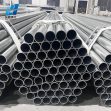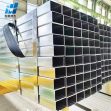Curtain Wall, Window Wall, or Storefront
In terms of the differences between curtain wall and window wall, curtain wall is generally attached to the building structure, self-supporting, and portray an expansive, uninterrupted glass appearance. For window walls, glazing is placed between a building’s concrete slabs, using the slabs as structural support. The system has a break between the glass, and slab edge covers are used to conceal the concrete. Furthermore, with fewer mullions and joints required, as compared to most window wall systems, curtain-wall systems act as a single unit and are therefore more resistant to air and moisture penetration in applications. Moreover, curtain wall can also deliver excellent structural integrity, require little maintenance, and has been typically used in commercial buildings.
In addition, curtain wall cost can run approximately twice as much as window wall cost in building construction. And installation is a complex process typically involving cranes or rigs to hoist the pieces from the building exterior. Whereas window walls contain repeatable components, they can be prefabricated in the shop to a greater extent, enabling fewer errors, less site disruptions, and a higher-quality product. The product also requires less engineering and incorporates more natural fire protection as the exterior wall is broken up by each floor’s concrete slab, which provides fire stopping. The separation of each window wall unit creates a sealed space with less noise transfer and energy loss.
Storefront is defined as a non-residential, non-load-bearing assembly of commercial entrance systems and windows, usually spanning between the floor and the structure above, designed for high use and strength. Storefront spans should be 10 feet high or less. Typically, storefront is only used on the ground floor of a building but can be used up to the second or third floor. Throwing storefronts into the mix, although typically limited to frame heights of up to 10 feet, these glazed systems are suitable for smaller commercial applications. In most cases, they’re used on the ground floor of a building, but they can also be designed for second floors. Storefronts are typically center glazed and not self-draining. While frame heights and building heights will go a long way in determining whether a storefront or curtain wall facade is most suitable for a given project, other factors include wind pressure, inter-story drift, floor movement, allowable deflections, vertical mullion spacing, and anchor points.
Dong Peng Bo Da Steel Pipe Group is a famous steel pipe manufacturer in China. We are committed to producing various types of steel products for your choice in your building project in future. Our products are all designed for the fast and easy installation of curtain walls. Contact us if you have any need in your project.
Tel: +86 18202256900 Email: steel@fwssteel.com










